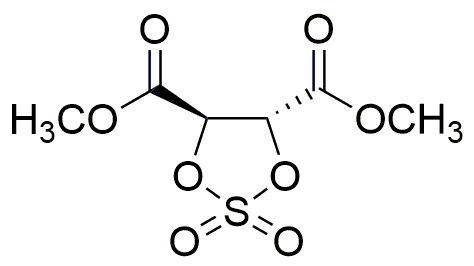Dimethyl (4R,5R)-1,3,2-dioxathiolane-4,5-dicarboxylate 2,2-dioxide is widely utilized in research focused on:
- Agricultural Chemistry: This compound serves as a potential pesticide or herbicide, helping to protect crops from pests and diseases while minimizing environmental impact.
- Pharmaceutical Development: Its unique structure allows for the synthesis of new drug candidates, particularly in the development of compounds that target specific biological pathways.
- Material Science: It can be used in the formulation of advanced materials, including polymers and coatings, enhancing durability and resistance to environmental factors.
- Analytical Chemistry: The compound is utilized as a reagent in various analytical techniques, aiding in the detection and quantification of other substances in complex mixtures.
- Green Chemistry: Its applications align with sustainable practices, as it can be involved in processes that reduce waste and energy consumption compared to traditional methods.
General Information
Properties
Safety and Regulations
Applications
Dimethyl (4R,5R)-1,3,2-dioxathiolane-4,5-dicarboxylate 2,2-dioxide is widely utilized in research focused on:
- Agricultural Chemistry: This compound serves as a potential pesticide or herbicide, helping to protect crops from pests and diseases while minimizing environmental impact.
- Pharmaceutical Development: Its unique structure allows for the synthesis of new drug candidates, particularly in the development of compounds that target specific biological pathways.
- Material Science: It can be used in the formulation of advanced materials, including polymers and coatings, enhancing durability and resistance to environmental factors.
- Analytical Chemistry: The compound is utilized as a reagent in various analytical techniques, aiding in the detection and quantification of other substances in complex mixtures.
- Green Chemistry: Its applications align with sustainable practices, as it can be involved in processes that reduce waste and energy consumption compared to traditional methods.
Documents
Safety Data Sheets (SDS)
The SDS provides comprehensive safety information on handling, storage, and disposal of the product.
Product Specification (PS)
The PS provides a comprehensive breakdown of the product’s properties, including chemical composition, physical state, purity, and storage requirements. It also details acceptable quality ranges and the product's intended applications.
Certificates of Analysis (COA)
Search for Certificates of Analysis (COA) by entering the products Lot Number. Lot and Batch Numbers can be found on a product’s label following the words ‘Lot’ or ‘Batch’.
*Catalog Number
*Lot Number
Certificates Of Origin (COO)
This COO confirms the country where the product was manufactured, and also details the materials and components used in it and whether it is derived from natural, synthetic, or other specific sources. This certificate may be required for customs, trade, and regulatory compliance.
*Catalog Number
*Lot Number
Safety Data Sheets (SDS)
The SDS provides comprehensive safety information on handling, storage, and disposal of the product.
DownloadProduct Specification (PS)
The PS provides a comprehensive breakdown of the product’s properties, including chemical composition, physical state, purity, and storage requirements. It also details acceptable quality ranges and the product's intended applications.
DownloadCertificates of Analysis (COA)
Search for Certificates of Analysis (COA) by entering the products Lot Number. Lot and Batch Numbers can be found on a product’s label following the words ‘Lot’ or ‘Batch’.
*Catalog Number
*Lot Number
Certificates Of Origin (COO)
This COO confirms the country where the product was manufactured, and also details the materials and components used in it and whether it is derived from natural, synthetic, or other specific sources. This certificate may be required for customs, trade, and regulatory compliance.


